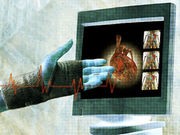

Cholesterol-lowering statin drugs should be used to prevent a first heart attack or stroke in certain at-risk patients, according to a draft recommendation released Monday by the nation’s leading experts in preventive medicine.
The U.S. Preventive Services Task Force said statins can provide maximum preventive benefits for adults 40 to 75 years old who have an existing risk factor for heart disease and at least a 10 percent or greater risk of a heart attack or stroke sometime within the next 10 years.
The independent panel added that people with a 10-year risk of heart attack and stroke between 7.5 percent and 10 percent might also benefit from statins, and should discuss the matter with their doctor.
“Cardiovascular disease is a leading cause of death, and people with no signs or symptoms or past history of cardiovascular disease can still be at risk,” said task force member Dr. Douglas Owens, a professor of medicine at Stanford University. “Our review indicates that some of these people can take a statin to prevent heart attacks and strokes.”
This is the first time that the U.S. Preventive Services Task Force (USPSTF) has addressed statins as a means of heading off heart attacks or strokes, Owens said. Up to now, the task force has mainly focused on the best screening methods for detecting heart disease.
“Our sense was the really pressing question now is about who should be taking a statin to help control their cholesterol levels,” Owens said.
Cholesterol can contribute to a person’s risk of heart attack and stroke. The waxy substance can build up along the inner walls of the arteries that feed blood to the heart and the brain. This can force the heart to pump harder and increase the chances that a blood clot will seal off the vessel and cause a heart attack or stroke, according to the American Heart Association.
Statins interfere with the production of cholesterol by the liver, and thus help lower “bad” LDL cholesterol and raise “good” HDL cholesterol levels in the bloodstream, according to the U.S. National Institutes of Health.
Statin therapy can decrease a person’s overall risk of death, as well as their risk of dying from or suffering a heart attack or stroke, concluded an evidence review conducted by the USPSTF.
The benefit appeared greatest in people between 40 and 75 years old who already have a risk factor for heart disease like high cholesterol, high blood pressure, diabetes or smoking, Owens said.
The task force also found that statin therapy makes the most sense in people with at least a 10 percent risk of having a heart attack or stroke within the next decade, based on their age and current health.
“Statins are effective drugs,” Owens said. “Based on the evidence we reviewed, we feel the benefits of taking a statin outweigh the harms in these populations.”
Statins also are inexpensive, with generic versions available in many cases, he added.
Statins aren’t risk-free, however. According to the U.S. Food and Drug Administration, some users have reported memory problems. There’s also an increased risk of type 2 diabetes and muscle damage, the agency said.
Owens could not say how many millions of Americans fall within the parameters of the new recommendations. People can assess their personal risk by visiting www.cvriskcalculator.com, an online calculator sponsored by the American Heart Association and the American College of Cardiology.
The task force also gave a limited recommendation for statin treatment of people with a 7.5 percent or higher risk who meet all the other criteria. “You could still benefit,” Owens said. “Our recommendation is to discuss it with your doctor. The greater your risk, the more likely you are to benefit from a statin.”
However, people at that lower level of risk are very likely to also benefit from lifestyle changes such as exercising more or eating a healthier diet, said Dr. Sidney Smith Jr., director of the Center for Cardiovascular Science and Medicine at the University of North Carolina in Chapel Hill.
“My concern is, given the choice between taking a pill or changing behavior, people will choose to take a pill and not deal with the lifestyle factors,” Smith said. “Taking the pill should not be a substitute for leading a healthy lifestyle, that’s for sure.”
Smith noted that the task force’s recommendations on statins closely resemble the guidelines already issued by the American Heart Association and the American College of Cardiology.
“It’s always reassuring when we have two or three different groups looking at the same question and coming back with the same answer,” he said.
The public can submit comments on the USPSTF’s draft recommendation through Jan. 25, 2016.
More information
To learn more about statins, visit the U.S. Food and Drug Administration.
Source: HealthDay
Copyright © 2025 HealthDay. All rights reserved.

Leave a Reply